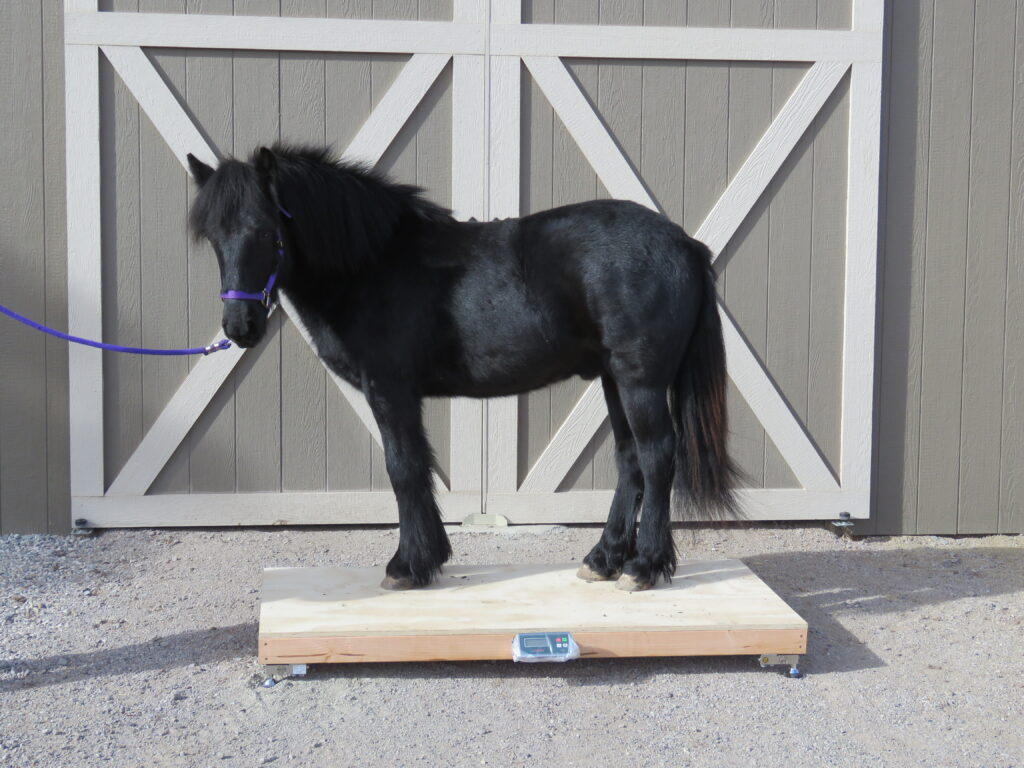
Weight tapes, calculations, and “eyeballing it” often don’t give you an accurate weight on a horse, as I discovered when I got myself an actual livestock scale.
There are a number of reasons why we horse owners might want or need to get an accurate weight on our horses. If you have growing young stock, a horse that needs to gain or lose weight, breeding animals, or you need to medicate, sedate or deworm a horse, knowing what your horse actually weighs and being able to monitor changes in weight can provide important and sometimes life-saving information. But most of us have no way to determine the weight of our horses with any real accuracy, relying instead on weight tapes, measurements with varying calculation formulas, or simply “eyeballing” it, all of which are notoriously inaccurate. Even veterinarians can be off by a significant amount when they guestimate the weight of a horse, which is why most clinics use a livestock scale to determine a horse’s true weight.
Many of us would love to have such a scale in our own barns, but if you’re like me, you probably imagine that the cost would be far beyond the budget for all but the wealthiest of horse owners. Even if you could afford one, who has room for a big, bulky thing like a livestock scale, right? But what if you found out that you could get a very accurate livestock scale that could easily lift up and store against a wall, all for a few hundred dollars? Would you get one? I did, and boy has it ever come in handy!
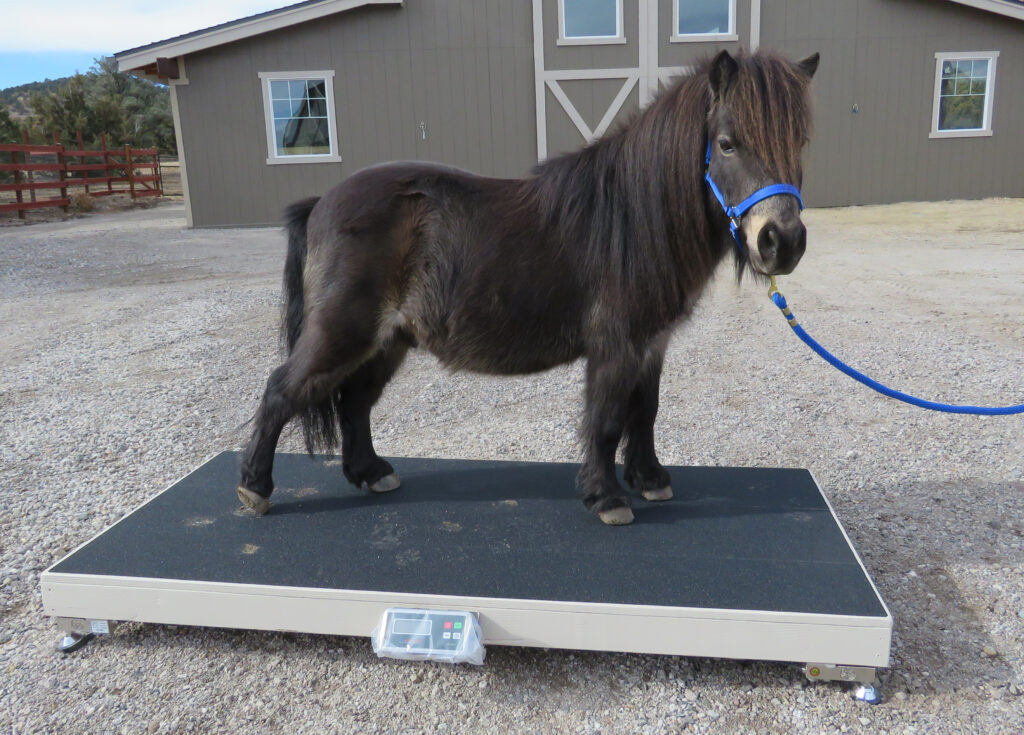
Being able to get an accurate weight on Peanut was important for medication dosage and for watching his weight.
I first felt the need for a scale when my miniature horse, Peanut, had a sore hock, and my farrier suggested giving him some pain meds before his trim to hopefully make trimming him more comfortable. But in doing some research, I learned that minis are extremely sensitive to some common pain medications, so it is important to have a very accurate weight on them to determine the correct dose. I also learned that weight tapes and measuring techniques are almost always incorrect when it comes to minis — as well as many other types of horses — so the only way to get a correct weight on any horse is to put it on a livestock scale. Usually, that means hauling them to a veterinary clinic, or some people resort to trailering to a landfill and weighing their rig with the horse in it, then unloading the horse and going through again to weigh the rig alone. Neither of these were options in my area, so I decided to see if there was by any chance a livestock scale out there that I might be able to get my hands on without breaking the bank.
I truly thought my search would come up empty, but then I came across a company called Prime USA Scales (primeusascales.com) that offers an impressively accurate livestock scale kit that can weigh up to 10,000 pounds to within one pound. The kit comes with everything you need to build your own scale except for whatever kind of platform you want to use. We built a very simple, strong, inexpensive and fairly light platform for my ponies out of 2 x 4 lumber on edge and a sheet of 3/4″ plywood. However, the scale kit can be used with existing platforms, attached to cattle chutes, or whatever works for you. Prime USA Scales even has videos to help you put your kit together, and I found the people there really nice and extremely knowledgeable should you have any questions. Here is a link to the specific kit I got: https://primeusascales.com/product/ps-720-10k-weighing-kit/ .
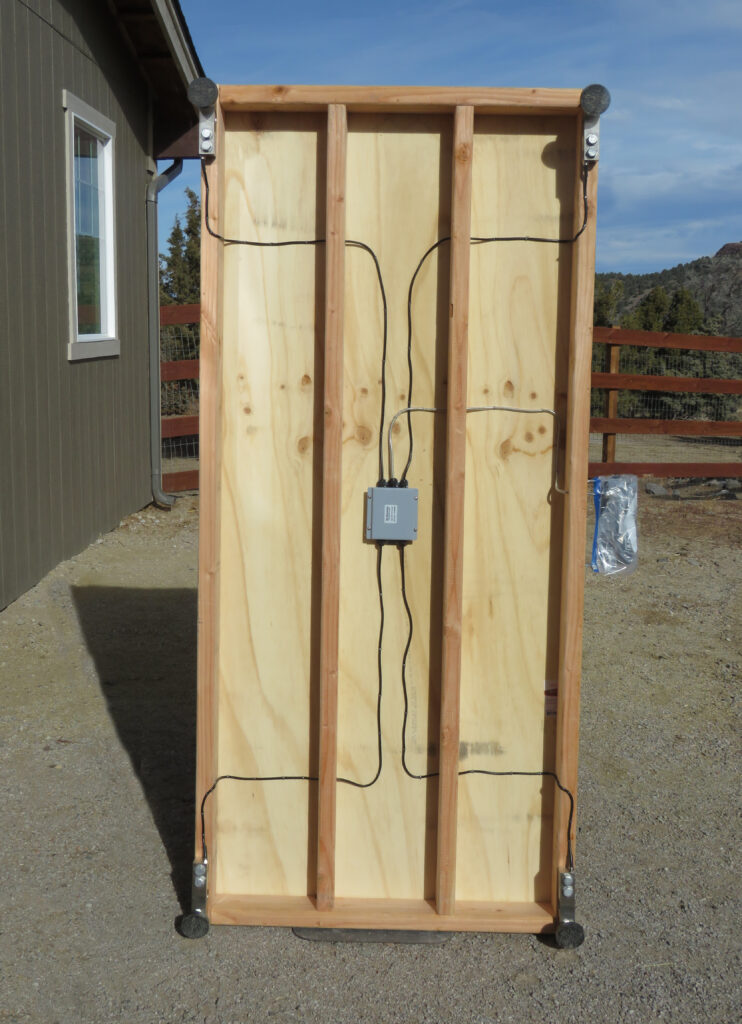
The underside of our scale shows how we built it, and how we wired it together.
Once I had my scale built, we calibrated it and tested its accuracy by weighing myself, my husband, and our 80 pound dog on our bathroom scale, then weighing all three of us together and individually on the livestock scale. The scale was spot on, so I was super excited to get my boys weighed!
What I found was that my mini, Peanut, weighed 309 pounds on the scale, while the tape said he weighed 345 pounds. That is enough of a difference to matter with some medications, a sobering thought when you’ve learned how easy it is to overdose minis with certain meds. As for my 20 month old Fell Pony, Zephyr, his actual weight on the scale was 820 pounds, while the tape said he weighed 60 pounds less than that. I asked some Fell Pony people about this and they said that Fells and other heavy-boned type ponies and horses typically weigh significantly more than what tapes or measuring/calculation formulas estimate, often 75-150 pounds more. One gal I know says the tapes are off by a good 200 pounds on her horse!
Hearing all of this, my friends Michele and Cindy got curious to know what their horses really weighed, so we took the scale over to Michele’s and weighed her mini, Jack, her Missouri Fox Trotter, Mosey, and Cindy’s Rocky Mountain Horse, Tonka. Michele also happens to be familiar with several of the measurement/calculation methods of weight estimation, so we looked at some of those to see how they compared to the scale and the weight tape. For simplicity’s sake, I have only included one of the most commonly used measurement/calculation methods, which is ((girth x girth) x length) / 330 in this chart:

This chart shows the varying weights we got for our horses depending on what method we used.
It was interesting to see that there was a consistent pattern of overestimation for minis, regardless of whether we used a tape or measurement/calculation, and a pattern of underestimation for our other equines. We also noted that for all the horses, the weight we got using the tape varied a fair amount according to where on the horse we placed the tape, and how tightly we pulled it. Thus, even if you were just using a tape to gauge if your horse is gaining or losing weight, rather than trying to get a precise weight at any given time, it would be difficult to know if you were placing and tightening it exactly the same way each time, and if you don’t, it could easily skew your results. It was not surprising that the tape was closest to being accurate for Mosey, who is an average sized horse with an average build, as that is the type of animal such tapes were designed for. Still, the tape was off by nearly 40 pounds, showing us just how nice it is to have an actual scale.
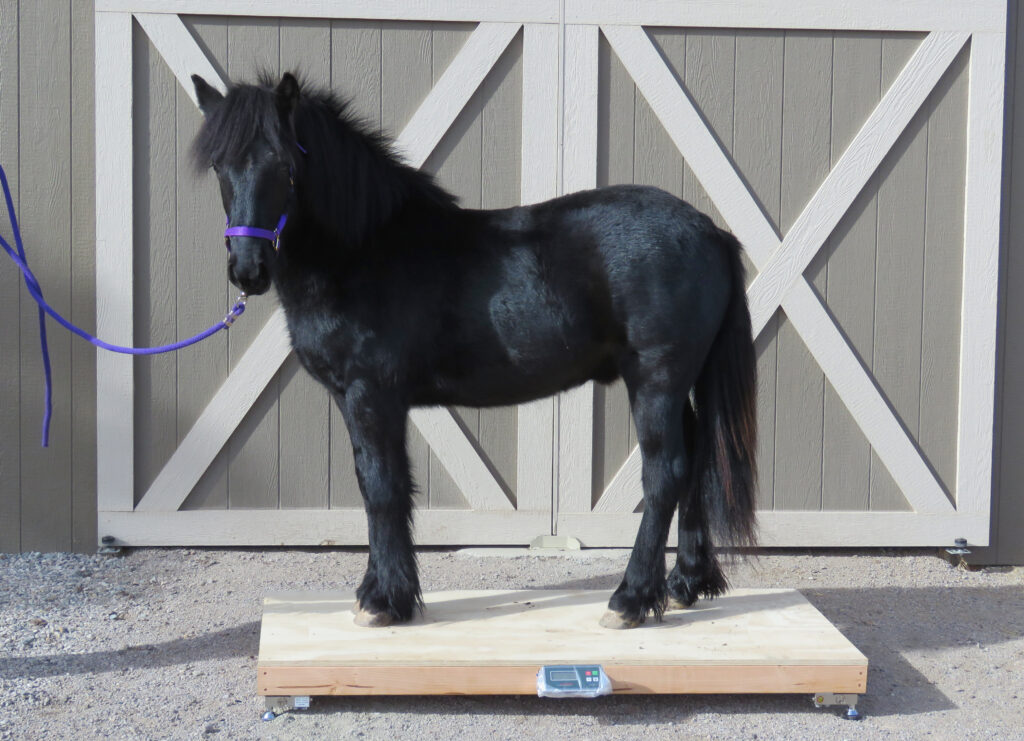
Zephyr, having the heavy-boned build of his Fell Pony breed, weighed significantly more on the scale than what the weight tape showed, which is typical for thicker built horses and ponies. This photo was taken before the addition of non-slip ramp tape, which I added because I found that plain plywood caused the horses to slip when they got off the scale. For reference, Zephyr is just over 13.2 here.
As for storing the scale, we just tip it up against a wall when it is not in use, then wheel it into place with a hand dolly when we want to use it. Michele and I — neither of whom are spring chickens — had no trouble wheeling it around, tipping it up onto her truck bed and sliding it in for easy transport.
A few tips:
- I strongly suggest putting some kind of non-slip surface on the platform, either tape, grit paint, or something else, as I saw that the horses tended to slip a bit when getting off the plain plywood platform, and some found this disconcerting. I didn’t have that at first but added it later.
- You can play with how and where you attach the digital indicator, the thingy that turns the scale on and off and shows you what the weight is. I put it on the middle on one side side, which is fine, but you just have to make sure that the horse doesn’t step off the platform and onto the indicator. Prime Scales USA do actually sell a wireless indicator, which would be fabulous to have, but as it costs more than the scale kit itself ($399), I opted to stick with the standard one.
- I have also covered the digital indicator with a plastic bag, just to keep it somewhat free from the thick pall of dust that coats everything in my high-desert barn. You don’t have to do this, as the entire kit is designed with livestock use and barns in mind, but I did it anyway.
- Lastly, and very importantly, don’t make the mistake I made of building your platform too small. Seventy-two by thirty inches seemed plenty big enough when I was planning the thing, and it is indeed fine for my large pony and mini. However, when we weighed Mosey, who is just under 15 hands, the platform suddenly seemed a bit small. Fortunately, Mosey is a very well-trained, cooperative kind of guy, so it wasn’t a problem, but I would definitely recommend going bigger if you are wanting to weigh full-sized horses.
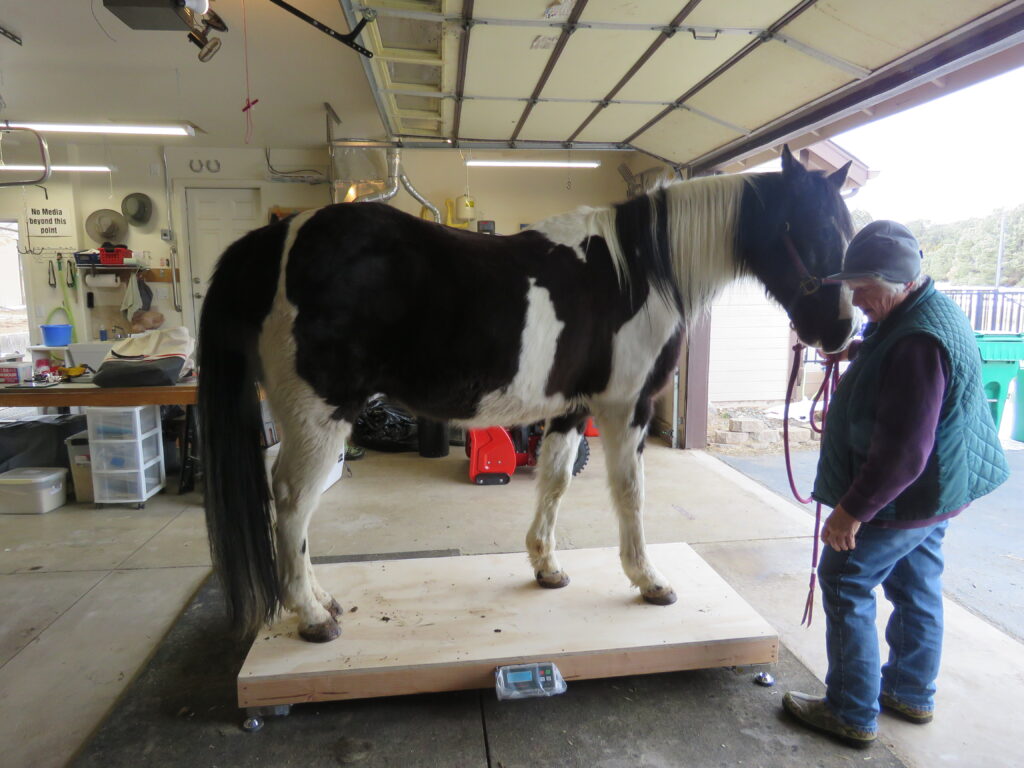
When we put Mosey, who is just under 15 hands, on the scale, my platform suddenly seemed quite small. If I had it to do over again, I would make it longer than 72″, though the 30″ width seems okay.
- The “feet” of the scale, which are actually the load-measuring cells, are somewhat adjustable, but it is best to place the scale on level ground so that it doesn’t tip back and forth.
- Don’t worry if your horse isn’t standing square on the platform or if they have their feet bunched up towards one end or the other. I have found that it doesn’t make any difference.
As word is getting around about my scale, it seems that quite a few people have “scale envy” and are wanting to get one for themselves, as the benefits of having an accurate, portable, and budget-friendly livestock scale are pretty apparent for horse people. I’ve also found it handy for weighing my big Pyrenees cross dogs, and hey, if you’ve got llamas, cows, pieces of equipment, tack, or anything else you need a weight on, this scale can handle it!
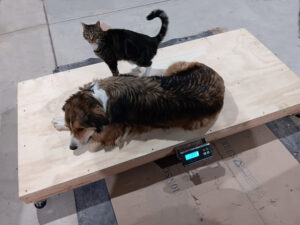
I am finding my livestock scale useful for my 80+ pound dogs like Bodie here. Not to be outdone, Taz kitty jumped aboard too!
If you want one too, PrimeUSAScales.com is kindly offering my readers a 10% discount if you use this code at checkout: weighmyhorse10 (I get no kickbacks from this and do not work for them). I’ve been using mine to monitor the weight of both my guys, who are on a diet, and to get the dosages right for deworming and medications. Let me know if you do get one, and what you learn about your horses!
– Susan Kauffmann